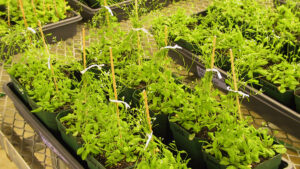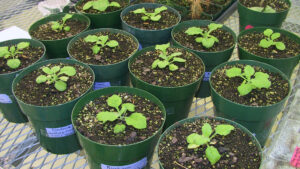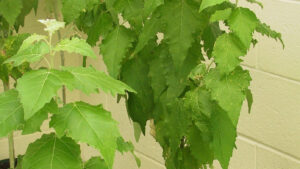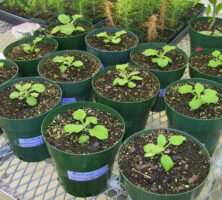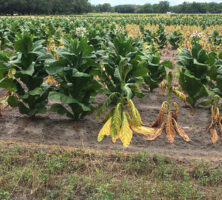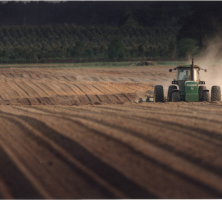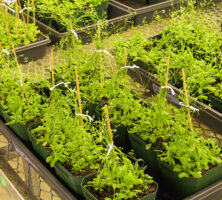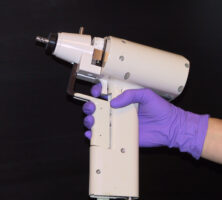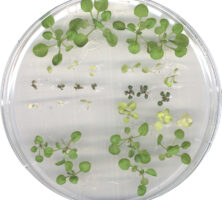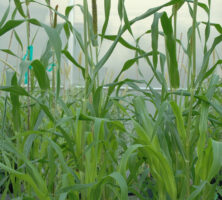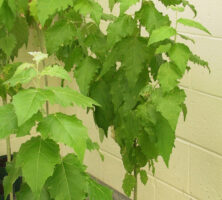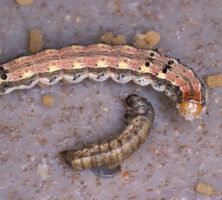The New Georgia Encyclopedia is supported by funding from A More Perfect Union, a special initiative of the National Endowment for the Humanities.
Transgenic, or genetically modified, tobacco plants grow in the laboratory of geneticist Richard Meagher at the University of Georgia.
Photograph by Sarah E. McKee, New Georgia Encyclopedia
The New Georgia Encyclopedia does not hold the copyright for this media resource and can neither grant nor deny permission to republish or reproduce the image online or in print. All requests for permission to publish or reproduce the resource must be submitted to the rights holder.
A tobacco farm in south Georgia. While researchers in Georgia have made advances in the field of genetic engineering to develop crops that are resistant to weeds and insects, most genetics research on tobacco in the state examines the plant's impact on public health.
Photograph from CAES Newsire, University of Georgia
The New Georgia Encyclopedia does not hold the copyright for this media resource and can neither grant nor deny permission to republish or reproduce the image online or in print. All requests for permission to publish or reproduce the resource must be submitted to the rights holder.
Georgia is the top producer of peanuts in the United States. Farmers in the state rely on genetics research, conducted at the National Peanut Research Laboratory in Dawson, the University of Georgia Tifton campus, and the Georgia Experiment Station in Griffin, to enhance peanut plants for higher yield and quality.
Courtesy of Special Collections & Archives, Georgia State University Library, Atlanta Journal-Constitution Photographic Archive.
The New Georgia Encyclopedia does not hold the copyright for this media resource and can neither grant nor deny permission to republish or reproduce the image online or in print. Requests for permission to publish or reproduce the resource should be submitted to Special Collections and Archives at Georgia State University.
The New Georgia Encyclopedia does not hold the copyright for this media resource and can neither grant nor deny permission to republish or reproduce the image online or in print. All requests for permission to publish or reproduce the resource must be submitted to the rights holder.
One of the many innovations introduced by Naomi Chapman Woodroof, an early pioneer in peanut research, was the use of bedsprings to separate peanuts from the plant during harvest. Woodroof worked at the Coastal Plain Experiment Station (later University of Georgia Tifton campus) from 1933 to 1967.
Courtesy of Jane Woodroof Akers
The New Georgia Encyclopedia does not hold the copyright for this media resource and can neither grant nor deny permission to republish or reproduce the image online or in print. All requests for permission to publish or reproduce the resource must be submitted to the rights holder.
Transgenic arabidopsis plants grow in the laboratory of geneticist Richard Meagher at the University of Georgia. Arabidopsis plants are commonly used in genetic engineering research because they grow and produce seeds quickly, allowing researchers to produce many generations in a relatively short period of time.
Photograph by Sarah E. McKee, New Georgia Encyclopedia
The New Georgia Encyclopedia does not hold the copyright for this media resource and can neither grant nor deny permission to republish or reproduce the image online or in print. All requests for permission to publish or reproduce the resource must be submitted to the rights holder.
A gene gun shoots small gold particles coated with selected genes from one organism into the plasma membrane of a target organism. The genes contain information for desirable traits, such as disease resistance, that researchers hope will be expressed by the target organism.
Photograph by Sarah E. McKee, New Georgia Encyclopedia
The New Georgia Encyclopedia does not hold the copyright for this media resource and can neither grant nor deny permission to republish or reproduce the image online or in print. All requests for permission to publish or reproduce the resource must be submitted to the rights holder.
Arabidopsis seedlings genetically engineered to resist toxic heavy metals grow on the right side of a petri dish in Richard Meagher's genetics laboratory at the University of Georgia. (Wild-type plants grow on the left.) Plants resistant to heavy metals and other toxins are used to clean the environment in a process known as phytoremediation.
Photograph by Melissa Pischke LeBlanc
The New Georgia Encyclopedia does not hold the copyright for this media resource and can neither grant nor deny permission to republish or reproduce the image online or in print. All requests for permission to publish or reproduce the resource must be submitted to the rights holder.
Genetically engineered, or transgenic, pearl millet plants grow in the lab of Peggy Ozais-Akins at the Coastal Plain Experiment Station (later University of Georgia Tifton campus) in Tifton. Ozais-Akins developed a system to make a transgenic pearl millet cell that can be genetically modified quickly and then coaxed to grow into a fertile plant.
Courtesy of Peggy Ozais-Akins
The New Georgia Encyclopedia does not hold the copyright for this media resource and can neither grant nor deny permission to republish or reproduce the image online or in print. All requests for permission to publish or reproduce the resource must be submitted to the rights holder.
Transgenic (genetically modified) yellow poplar trees grow in the laboratory of geneticist Richard Meagher at the University of Georgia. Researchers at UGA engineered a strain of yellow poplar capable of growing in soil contaminated with mercury and converting the metal into a less harmful form. The process of using plants to remove toxins from the environment is called phytoremediation.
Photograph by Sarah E. McKee, New Georgia Encyclopedia
The New Georgia Encyclopedia does not hold the copyright for this media resource and can neither grant nor deny permission to republish or reproduce the image online or in print. All requests for permission to publish or reproduce the resource must be submitted to the rights holder.
Cotton plays a significant role in the state's economy. In order to increase crop yield and minimize dangerous pesticide use, many Georgia farmers grow cotton plants that are genetically modified to resist insects and specific herbicides. By 2004 such transgenic cotton accounted for 95 percent of Georgia's total crop.
Courtesy of Agricultural Research Service, U.S. Department of Agriculture
The New Georgia Encyclopedia does not hold the copyright for this media resource and can neither grant nor deny permission to republish or reproduce the image online or in print. All requests for permission to publish or reproduce the resource must be submitted to the rights holder.
Budworms are pest insects that cause significant problems for cotton farmers in Georgia. Through advances in genetic engineering, scientists have developed a cotton plant resistant to budworms and other pests, including bollworms and spider mites.
Courtesy of Agricultural Research Service, U.S. Department of Agriculture
The New Georgia Encyclopedia does not hold the copyright for this media resource and can neither grant nor deny permission to republish or reproduce the image online or in print. All requests for permission to publish or reproduce the resource must be submitted to the rights holder.
